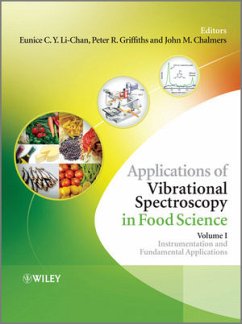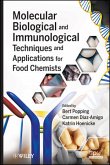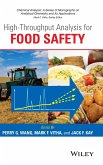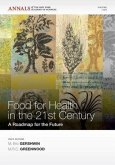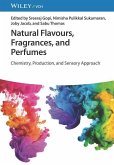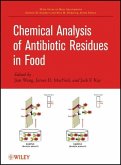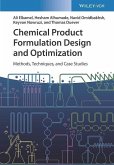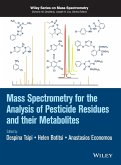Applications of Vibrational Spectroscopy in Food Science, 2 Volume Set
Herausgeber: Li-Chan, Eunice; Griffiths, Peter R; Chalmers, John M
Applications of Vibrational Spectroscopy in Food Science, 2 Volume Set
Herausgeber: Li-Chan, Eunice; Griffiths, Peter R; Chalmers, John M
- Gebundenes Buch
- Merkliste
- Auf die Merkliste
- Bewerten Bewerten
- Teilen
- Produkt teilen
- Produkterinnerung
- Produkterinnerung
Bringing several disparate aspects of food science and analysis together in one place, Applications of Vibrational Spectroscopy to Food Science provides a comprehensive, state-of the-art text presenting the fundamentals of the methodology, as well as underlying current areas of research in food science analysis. All of the major spectroscopic techniques are also covered - showing how each one can be used beneficially and in a complementary approach for certain applications. Case studies illustrate the many applications in vibrational spectroscopy to the analysis of foodstuffs.
Andere Kunden interessierten sich auch für
![Molecular Biological and Immunological Techniques and Applications for Food Chemists Molecular Biological and Immunological Techniques and Applications for Food Chemists]() Molecular Biological and Immunological Techniques and Applications for Food Chemists189,99 €
Molecular Biological and Immunological Techniques and Applications for Food Chemists189,99 €![High-Throughput Analysis for Food Safety High-Throughput Analysis for Food Safety]() High-Throughput Analysis for Food Safety145,99 €
High-Throughput Analysis for Food Safety145,99 €![Foods for Health in the 21st Century Foods for Health in the 21st Century]() Foods for Health in the 21st Century156,99 €
Foods for Health in the 21st Century156,99 €![Natural Flavours, Fragrances, and Perfumes Natural Flavours, Fragrances, and Perfumes]() Natural Flavours, Fragrances, and Perfumes139,00 €
Natural Flavours, Fragrances, and Perfumes139,00 €![Chemical Analysis of Antibiotic Residues in Food Chemical Analysis of Antibiotic Residues in Food]() Chemical Analysis of Antibiotic Residues in Food149,99 €
Chemical Analysis of Antibiotic Residues in Food149,99 €![Chemical Product Formulation Design and Optimization Chemical Product Formulation Design and Optimization]() Ali ElkamelChemical Product Formulation Design and Optimization80,99 €
Ali ElkamelChemical Product Formulation Design and Optimization80,99 €![Mass Spectrometry for the Analysis of Pesticide Residues and their Metabolites Mass Spectrometry for the Analysis of Pesticide Residues and their Metabolites]() Despina TsipiMass Spectrometry for the Analysis of Pesticide Residues and their Metabolites145,99 €
Despina TsipiMass Spectrometry for the Analysis of Pesticide Residues and their Metabolites145,99 €-
-
-
Bringing several disparate aspects of food science and analysis together in one place, Applications of Vibrational Spectroscopy to Food Science provides a comprehensive, state-of the-art text presenting the fundamentals of the methodology, as well as underlying current areas of research in food science analysis. All of the major spectroscopic techniques are also covered - showing how each one can be used beneficially and in a complementary approach for certain applications. Case studies illustrate the many applications in vibrational spectroscopy to the analysis of foodstuffs.
Hinweis: Dieser Artikel kann nur an eine deutsche Lieferadresse ausgeliefert werden.
Hinweis: Dieser Artikel kann nur an eine deutsche Lieferadresse ausgeliefert werden.
Produktdetails
- Produktdetails
- Verlag: John Wiley & Sons / Wiley
- Seitenzahl: 752
- Erscheinungstermin: 1. November 2010
- Englisch
- Abmessung: 251mm x 191mm x 46mm
- Gewicht: 2245g
- ISBN-13: 9780470742990
- ISBN-10: 0470742992
- Artikelnr.: 30589533
- Herstellerkennzeichnung
- Libri GmbH
- Europaallee 1
- 36244 Bad Hersfeld
- gpsr@libri.de
- Verlag: John Wiley & Sons / Wiley
- Seitenzahl: 752
- Erscheinungstermin: 1. November 2010
- Englisch
- Abmessung: 251mm x 191mm x 46mm
- Gewicht: 2245g
- ISBN-13: 9780470742990
- ISBN-10: 0470742992
- Artikelnr.: 30589533
- Herstellerkennzeichnung
- Libri GmbH
- Europaallee 1
- 36244 Bad Hersfeld
- gpsr@libri.de
Eunice Y.C. Li-Chan is Professor of Chemistry at the University of British Columbia. B.Sc. (Agr), Food Science, The University of British Columbia, M.Sc., Biochemistry, The University of Alberta, Ph.D., Food Science, The University of British Columbia. Her research interests are to: elucidate structure-function relationships of food proteins &peptides; apply Raman and other spectroscopic methods to study food systems; discover peptides & proteins with specific biological or functional activity for use as value added-products from the food industry John Chalmers is an independent consultant in the field of vibrational spectroscopy, as well as a Reader at the University of Nottingham. John left ICI in 1997 after 22 years, serving as a Business Research Associate in the Science Support Group of ICI Technology. He is chairman of the UK Infrared and Raman Discussion Group (IRDG) and current chairman of the RSC (Royal Society of Chemistry) Molecular Spectroscopy Subject Group. He is a member of the Association of British Spectroscopists (ABS) Trust. He is a Fellow of the Royal Society of Chemistry. In 1994, he received the Williams-Wright Award from the Coblentz Society. Peter Griffiths is a Professor of Chemistry at the University of Idaho. In 1972, he joined the faculty of Ohio University, becoming Distinguished Professor less than 10 years later. After spending 7 years on the faculty of the University of California, Riverside, he was appointed chair of the Department of Chemistry at the University of Idaho, a post he held for 8 years. Professor Griffiths has published 4 books, 25 book chapters and over 200 papers in the area of vibrational spectroscopy. He has received various awards, including the Spectroscopy Society of Pittsburgh Award and the Fritz Pregl Medal of the Austrian Society of Analytical Chemistry.
Volume I: Instrumentation and Fundamental Applications.
Preface.
Acknowledgments.
List of Contributors.
Part One. Introduction & Basic Concepts.
Introduction to Vibrational Spectroscopy in Food Science (Eunice C. Y.
Li-Chan).
Introduction to the Theory and Instrumentation for Vibrational Spectroscopy
(Peter R. Griffiths).
Vibrational Spectroscopy: Sampling Techniques and Fiber-optic Probes (John
M. Chalmers and Peter R. Griffiths).
Chemometrics in Biospectroscopy (Achim Kohler, Nils Kristian Afseth and
Harald Martens).
Part Two. Advances in Instrumentation for Food Analysis.
Infrared Imaging: Princples and Practices (Jacqueline Sedman, Andrew
Ghetler, Alexander Enfield and Ashraf A. Asmail).
The Role of Confocal Raman Spectroscopy in Food Science (Paul D. A. Pudney
and Thomas M. Hancewicz).
Raman Spectroscopic Imaging (Patrick J. Treado, Ryan J. Priore and Matthew
P. Nelson).
Surface-enhanced Raman Spectroscopy: Theory and Application to the Analysis
of Chlorpyrifos in Orange Juice (Chetan Shende, Frank Inscore, Atanu
Sengupta and Stuart Farquharson).
Part Three. Fundamental Research to Elucidate Properties & Processing
Induced Changes.
Application of Vibrational Spectroscopy for the Study of Heat-induced
Changes in Food Components (Daniel E. Rubio-Diaz and Luis E.
Rodriguez-Saona).
Chemical Changes during Freezing and Frozen Storage of Fish Investigated by
Vibrational Spectroscopy (Pedro Carmona, Isabel Sánchez-Alonso and Mercedes
Careche).
Application of Vibrational Spectroscopy to Investigate Radiation-induced
Changes in Food (Feride Severcan and Ozlem Bozkurt).
The Potential of Mid-infrared Spectroscopy for Monitoring Changes in
Polysaccharides and Other Carbohydrates during Processing (Manuel A.
Coimbra, Alexander Nunes, António S. Barros and Ivonne Delgadillo).
Monitoring Oxidation of Lipids in Edible Oils and Complex Food Systems by
Vibrational Spectroscopy (Maria José Ayora-Cañada, Ana Domímguez-Vidal and
Bernhard Lendl).
Rama n Spectroscopy for the Study of Molecular Order, Thermodynamics, ad
Solid-Liquid Transitions in Triacylgycerols (Eric Da Silva and Dérick
Rousseau).
Applications of Vibrational Spectroscopy to Study Protein Structural
Changes in Muscle and Meat Batter Systems (Ana M. Herrero, Pedro Carmona,
Francisco Jiménez-Colmenero and Claudia Ruíz-Capillas).
The Role and Potential of Vibrational Spectroscopy in the Study and
Characterization of Traditional and Novel Food Packaging Structures (Jose
M. Magaron and A. Lopez-Rubio).
Volume II. Analysis of Food, Drink and Related Materials.
Part Four. Examples of Applications for Food Analysis and Quality
Assurance.
The Analysis of Wheat by Near-infrared Spectroscopy (Phil Williams).
In situ Fourier Transform Infrared Microspectroscopy and Imaging of Wheat
Kernels and Other Grains (David L. Wetzel and Lauren R. Brewer).
The Analysis of Rice by Vibrational Spectroscopy (David S. Himmelsbach).
Applications of Vibrational Spectroscopy to Oilseeds Analysis (Malgorzata
Baranska, Hartwig Schulz, Marion Strehle and Jürgen Popp).
Vibrational Spectroscopy Techniques in the Quality Assessment of Fruits and
Vegetables (Evgeny Polshin, Jeroen Lammertyn and Bart M. Nicolaï).
Applications of Vibrational Spectroscopy to the Analysis of Fish and Other
Aquatic Food Products (Musleh Uddin and Emiko Okazaki).
Quantifying Meat Properties using Near-infrared Spectroscopy (Robert
Burling-Claridge).
Quality Analysis of Milk by Vibrational Spectroscopy (Achim Kohler, Nils
Kristian Afseth, Kjetil Jørgensen, Åshild Randby and Harald Martens).
Applications of Vibrational Spectroscopy to the Study of Cheese and Other
Fermented, Solid and Semi-solid Dairy Products (Colette C. Fagan and Colm
P. O'Donnell).
Progression to Fatty Acid Profiling of Edible Fats and Oils Using
Vibrational Spectroscopy (Hormoz Azizian, John K. G. Kramer and Magdi M.
Mossoba).
The Analysis of Grapes, Wine, and Other Alcoholic Beverages by Infrared
Spectroscopy (Mark Gishen, Daniel Cozzolino and Robert G. Dambergs).
Analysis of Caffeine , Sweeteners, and Other Additives in Beverages by
Vibrational Spectroscopy (Salvador Garriques Armenta and Miguel de la
Guardia).
Applicaions of Vibrational Spectroscopy to the Analysis of Polysaccharide
and Hydrocolloid Ingredients (Siu-Mei Choi, Sze-Yuen, David Lee Phillips
and Ching-Yung Ma).
Part Five. Applications Related to Food Safety and Regulatory Compliance.
Regulatory Considerations in Applying Vibrational Spectroscopic Methods for
Quality Control (Vincent Baeten, Juan Antonio Fernández Pierna, Frédéric
Dehareng, Georges Sinnaeve and Pierre Dardenne).
Authentication and Traceability of Agricultural and Food Products Using
Vibrational Spectroscopy to the Analysis of Trans Fats in Foods for
Regulatory Compliance in the USA (Magdi M. Mossoba, Julie Moss, John K. G.
Kramer and Hormoz Azizian).
The Application of Surface-enhanced Raman Spectroscopy to Identify and
Quantify Chemical Adulterants or Contaminants in Foods (Mengshi Lin).
Detection of Melamine in Foodstuffs by Vibrational Spectroscopy (Peter R.
Griffiths).
Investigating Food Spoilage and Pathogenic Microorganisms by Mid-infrared
Spectroscopy (Xiaonan Lu and Barbara Rasco).
Index.
Preface.
Acknowledgments.
List of Contributors.
Part One. Introduction & Basic Concepts.
Introduction to Vibrational Spectroscopy in Food Science (Eunice C. Y.
Li-Chan).
Introduction to the Theory and Instrumentation for Vibrational Spectroscopy
(Peter R. Griffiths).
Vibrational Spectroscopy: Sampling Techniques and Fiber-optic Probes (John
M. Chalmers and Peter R. Griffiths).
Chemometrics in Biospectroscopy (Achim Kohler, Nils Kristian Afseth and
Harald Martens).
Part Two. Advances in Instrumentation for Food Analysis.
Infrared Imaging: Princples and Practices (Jacqueline Sedman, Andrew
Ghetler, Alexander Enfield and Ashraf A. Asmail).
The Role of Confocal Raman Spectroscopy in Food Science (Paul D. A. Pudney
and Thomas M. Hancewicz).
Raman Spectroscopic Imaging (Patrick J. Treado, Ryan J. Priore and Matthew
P. Nelson).
Surface-enhanced Raman Spectroscopy: Theory and Application to the Analysis
of Chlorpyrifos in Orange Juice (Chetan Shende, Frank Inscore, Atanu
Sengupta and Stuart Farquharson).
Part Three. Fundamental Research to Elucidate Properties & Processing
Induced Changes.
Application of Vibrational Spectroscopy for the Study of Heat-induced
Changes in Food Components (Daniel E. Rubio-Diaz and Luis E.
Rodriguez-Saona).
Chemical Changes during Freezing and Frozen Storage of Fish Investigated by
Vibrational Spectroscopy (Pedro Carmona, Isabel Sánchez-Alonso and Mercedes
Careche).
Application of Vibrational Spectroscopy to Investigate Radiation-induced
Changes in Food (Feride Severcan and Ozlem Bozkurt).
The Potential of Mid-infrared Spectroscopy for Monitoring Changes in
Polysaccharides and Other Carbohydrates during Processing (Manuel A.
Coimbra, Alexander Nunes, António S. Barros and Ivonne Delgadillo).
Monitoring Oxidation of Lipids in Edible Oils and Complex Food Systems by
Vibrational Spectroscopy (Maria José Ayora-Cañada, Ana Domímguez-Vidal and
Bernhard Lendl).
Rama n Spectroscopy for the Study of Molecular Order, Thermodynamics, ad
Solid-Liquid Transitions in Triacylgycerols (Eric Da Silva and Dérick
Rousseau).
Applications of Vibrational Spectroscopy to Study Protein Structural
Changes in Muscle and Meat Batter Systems (Ana M. Herrero, Pedro Carmona,
Francisco Jiménez-Colmenero and Claudia Ruíz-Capillas).
The Role and Potential of Vibrational Spectroscopy in the Study and
Characterization of Traditional and Novel Food Packaging Structures (Jose
M. Magaron and A. Lopez-Rubio).
Volume II. Analysis of Food, Drink and Related Materials.
Part Four. Examples of Applications for Food Analysis and Quality
Assurance.
The Analysis of Wheat by Near-infrared Spectroscopy (Phil Williams).
In situ Fourier Transform Infrared Microspectroscopy and Imaging of Wheat
Kernels and Other Grains (David L. Wetzel and Lauren R. Brewer).
The Analysis of Rice by Vibrational Spectroscopy (David S. Himmelsbach).
Applications of Vibrational Spectroscopy to Oilseeds Analysis (Malgorzata
Baranska, Hartwig Schulz, Marion Strehle and Jürgen Popp).
Vibrational Spectroscopy Techniques in the Quality Assessment of Fruits and
Vegetables (Evgeny Polshin, Jeroen Lammertyn and Bart M. Nicolaï).
Applications of Vibrational Spectroscopy to the Analysis of Fish and Other
Aquatic Food Products (Musleh Uddin and Emiko Okazaki).
Quantifying Meat Properties using Near-infrared Spectroscopy (Robert
Burling-Claridge).
Quality Analysis of Milk by Vibrational Spectroscopy (Achim Kohler, Nils
Kristian Afseth, Kjetil Jørgensen, Åshild Randby and Harald Martens).
Applications of Vibrational Spectroscopy to the Study of Cheese and Other
Fermented, Solid and Semi-solid Dairy Products (Colette C. Fagan and Colm
P. O'Donnell).
Progression to Fatty Acid Profiling of Edible Fats and Oils Using
Vibrational Spectroscopy (Hormoz Azizian, John K. G. Kramer and Magdi M.
Mossoba).
The Analysis of Grapes, Wine, and Other Alcoholic Beverages by Infrared
Spectroscopy (Mark Gishen, Daniel Cozzolino and Robert G. Dambergs).
Analysis of Caffeine , Sweeteners, and Other Additives in Beverages by
Vibrational Spectroscopy (Salvador Garriques Armenta and Miguel de la
Guardia).
Applicaions of Vibrational Spectroscopy to the Analysis of Polysaccharide
and Hydrocolloid Ingredients (Siu-Mei Choi, Sze-Yuen, David Lee Phillips
and Ching-Yung Ma).
Part Five. Applications Related to Food Safety and Regulatory Compliance.
Regulatory Considerations in Applying Vibrational Spectroscopic Methods for
Quality Control (Vincent Baeten, Juan Antonio Fernández Pierna, Frédéric
Dehareng, Georges Sinnaeve and Pierre Dardenne).
Authentication and Traceability of Agricultural and Food Products Using
Vibrational Spectroscopy to the Analysis of Trans Fats in Foods for
Regulatory Compliance in the USA (Magdi M. Mossoba, Julie Moss, John K. G.
Kramer and Hormoz Azizian).
The Application of Surface-enhanced Raman Spectroscopy to Identify and
Quantify Chemical Adulterants or Contaminants in Foods (Mengshi Lin).
Detection of Melamine in Foodstuffs by Vibrational Spectroscopy (Peter R.
Griffiths).
Investigating Food Spoilage and Pathogenic Microorganisms by Mid-infrared
Spectroscopy (Xiaonan Lu and Barbara Rasco).
Index.
Volume I: Instrumentation and Fundamental Applications.
Preface.
Acknowledgments.
List of Contributors.
Part One. Introduction & Basic Concepts.
Introduction to Vibrational Spectroscopy in Food Science (Eunice C. Y.
Li-Chan).
Introduction to the Theory and Instrumentation for Vibrational Spectroscopy
(Peter R. Griffiths).
Vibrational Spectroscopy: Sampling Techniques and Fiber-optic Probes (John
M. Chalmers and Peter R. Griffiths).
Chemometrics in Biospectroscopy (Achim Kohler, Nils Kristian Afseth and
Harald Martens).
Part Two. Advances in Instrumentation for Food Analysis.
Infrared Imaging: Princples and Practices (Jacqueline Sedman, Andrew
Ghetler, Alexander Enfield and Ashraf A. Asmail).
The Role of Confocal Raman Spectroscopy in Food Science (Paul D. A. Pudney
and Thomas M. Hancewicz).
Raman Spectroscopic Imaging (Patrick J. Treado, Ryan J. Priore and Matthew
P. Nelson).
Surface-enhanced Raman Spectroscopy: Theory and Application to the Analysis
of Chlorpyrifos in Orange Juice (Chetan Shende, Frank Inscore, Atanu
Sengupta and Stuart Farquharson).
Part Three. Fundamental Research to Elucidate Properties & Processing
Induced Changes.
Application of Vibrational Spectroscopy for the Study of Heat-induced
Changes in Food Components (Daniel E. Rubio-Diaz and Luis E.
Rodriguez-Saona).
Chemical Changes during Freezing and Frozen Storage of Fish Investigated by
Vibrational Spectroscopy (Pedro Carmona, Isabel Sánchez-Alonso and Mercedes
Careche).
Application of Vibrational Spectroscopy to Investigate Radiation-induced
Changes in Food (Feride Severcan and Ozlem Bozkurt).
The Potential of Mid-infrared Spectroscopy for Monitoring Changes in
Polysaccharides and Other Carbohydrates during Processing (Manuel A.
Coimbra, Alexander Nunes, António S. Barros and Ivonne Delgadillo).
Monitoring Oxidation of Lipids in Edible Oils and Complex Food Systems by
Vibrational Spectroscopy (Maria José Ayora-Cañada, Ana Domímguez-Vidal and
Bernhard Lendl).
Rama n Spectroscopy for the Study of Molecular Order, Thermodynamics, ad
Solid-Liquid Transitions in Triacylgycerols (Eric Da Silva and Dérick
Rousseau).
Applications of Vibrational Spectroscopy to Study Protein Structural
Changes in Muscle and Meat Batter Systems (Ana M. Herrero, Pedro Carmona,
Francisco Jiménez-Colmenero and Claudia Ruíz-Capillas).
The Role and Potential of Vibrational Spectroscopy in the Study and
Characterization of Traditional and Novel Food Packaging Structures (Jose
M. Magaron and A. Lopez-Rubio).
Volume II. Analysis of Food, Drink and Related Materials.
Part Four. Examples of Applications for Food Analysis and Quality
Assurance.
The Analysis of Wheat by Near-infrared Spectroscopy (Phil Williams).
In situ Fourier Transform Infrared Microspectroscopy and Imaging of Wheat
Kernels and Other Grains (David L. Wetzel and Lauren R. Brewer).
The Analysis of Rice by Vibrational Spectroscopy (David S. Himmelsbach).
Applications of Vibrational Spectroscopy to Oilseeds Analysis (Malgorzata
Baranska, Hartwig Schulz, Marion Strehle and Jürgen Popp).
Vibrational Spectroscopy Techniques in the Quality Assessment of Fruits and
Vegetables (Evgeny Polshin, Jeroen Lammertyn and Bart M. Nicolaï).
Applications of Vibrational Spectroscopy to the Analysis of Fish and Other
Aquatic Food Products (Musleh Uddin and Emiko Okazaki).
Quantifying Meat Properties using Near-infrared Spectroscopy (Robert
Burling-Claridge).
Quality Analysis of Milk by Vibrational Spectroscopy (Achim Kohler, Nils
Kristian Afseth, Kjetil Jørgensen, Åshild Randby and Harald Martens).
Applications of Vibrational Spectroscopy to the Study of Cheese and Other
Fermented, Solid and Semi-solid Dairy Products (Colette C. Fagan and Colm
P. O'Donnell).
Progression to Fatty Acid Profiling of Edible Fats and Oils Using
Vibrational Spectroscopy (Hormoz Azizian, John K. G. Kramer and Magdi M.
Mossoba).
The Analysis of Grapes, Wine, and Other Alcoholic Beverages by Infrared
Spectroscopy (Mark Gishen, Daniel Cozzolino and Robert G. Dambergs).
Analysis of Caffeine , Sweeteners, and Other Additives in Beverages by
Vibrational Spectroscopy (Salvador Garriques Armenta and Miguel de la
Guardia).
Applicaions of Vibrational Spectroscopy to the Analysis of Polysaccharide
and Hydrocolloid Ingredients (Siu-Mei Choi, Sze-Yuen, David Lee Phillips
and Ching-Yung Ma).
Part Five. Applications Related to Food Safety and Regulatory Compliance.
Regulatory Considerations in Applying Vibrational Spectroscopic Methods for
Quality Control (Vincent Baeten, Juan Antonio Fernández Pierna, Frédéric
Dehareng, Georges Sinnaeve and Pierre Dardenne).
Authentication and Traceability of Agricultural and Food Products Using
Vibrational Spectroscopy to the Analysis of Trans Fats in Foods for
Regulatory Compliance in the USA (Magdi M. Mossoba, Julie Moss, John K. G.
Kramer and Hormoz Azizian).
The Application of Surface-enhanced Raman Spectroscopy to Identify and
Quantify Chemical Adulterants or Contaminants in Foods (Mengshi Lin).
Detection of Melamine in Foodstuffs by Vibrational Spectroscopy (Peter R.
Griffiths).
Investigating Food Spoilage and Pathogenic Microorganisms by Mid-infrared
Spectroscopy (Xiaonan Lu and Barbara Rasco).
Index.
Preface.
Acknowledgments.
List of Contributors.
Part One. Introduction & Basic Concepts.
Introduction to Vibrational Spectroscopy in Food Science (Eunice C. Y.
Li-Chan).
Introduction to the Theory and Instrumentation for Vibrational Spectroscopy
(Peter R. Griffiths).
Vibrational Spectroscopy: Sampling Techniques and Fiber-optic Probes (John
M. Chalmers and Peter R. Griffiths).
Chemometrics in Biospectroscopy (Achim Kohler, Nils Kristian Afseth and
Harald Martens).
Part Two. Advances in Instrumentation for Food Analysis.
Infrared Imaging: Princples and Practices (Jacqueline Sedman, Andrew
Ghetler, Alexander Enfield and Ashraf A. Asmail).
The Role of Confocal Raman Spectroscopy in Food Science (Paul D. A. Pudney
and Thomas M. Hancewicz).
Raman Spectroscopic Imaging (Patrick J. Treado, Ryan J. Priore and Matthew
P. Nelson).
Surface-enhanced Raman Spectroscopy: Theory and Application to the Analysis
of Chlorpyrifos in Orange Juice (Chetan Shende, Frank Inscore, Atanu
Sengupta and Stuart Farquharson).
Part Three. Fundamental Research to Elucidate Properties & Processing
Induced Changes.
Application of Vibrational Spectroscopy for the Study of Heat-induced
Changes in Food Components (Daniel E. Rubio-Diaz and Luis E.
Rodriguez-Saona).
Chemical Changes during Freezing and Frozen Storage of Fish Investigated by
Vibrational Spectroscopy (Pedro Carmona, Isabel Sánchez-Alonso and Mercedes
Careche).
Application of Vibrational Spectroscopy to Investigate Radiation-induced
Changes in Food (Feride Severcan and Ozlem Bozkurt).
The Potential of Mid-infrared Spectroscopy for Monitoring Changes in
Polysaccharides and Other Carbohydrates during Processing (Manuel A.
Coimbra, Alexander Nunes, António S. Barros and Ivonne Delgadillo).
Monitoring Oxidation of Lipids in Edible Oils and Complex Food Systems by
Vibrational Spectroscopy (Maria José Ayora-Cañada, Ana Domímguez-Vidal and
Bernhard Lendl).
Rama n Spectroscopy for the Study of Molecular Order, Thermodynamics, ad
Solid-Liquid Transitions in Triacylgycerols (Eric Da Silva and Dérick
Rousseau).
Applications of Vibrational Spectroscopy to Study Protein Structural
Changes in Muscle and Meat Batter Systems (Ana M. Herrero, Pedro Carmona,
Francisco Jiménez-Colmenero and Claudia Ruíz-Capillas).
The Role and Potential of Vibrational Spectroscopy in the Study and
Characterization of Traditional and Novel Food Packaging Structures (Jose
M. Magaron and A. Lopez-Rubio).
Volume II. Analysis of Food, Drink and Related Materials.
Part Four. Examples of Applications for Food Analysis and Quality
Assurance.
The Analysis of Wheat by Near-infrared Spectroscopy (Phil Williams).
In situ Fourier Transform Infrared Microspectroscopy and Imaging of Wheat
Kernels and Other Grains (David L. Wetzel and Lauren R. Brewer).
The Analysis of Rice by Vibrational Spectroscopy (David S. Himmelsbach).
Applications of Vibrational Spectroscopy to Oilseeds Analysis (Malgorzata
Baranska, Hartwig Schulz, Marion Strehle and Jürgen Popp).
Vibrational Spectroscopy Techniques in the Quality Assessment of Fruits and
Vegetables (Evgeny Polshin, Jeroen Lammertyn and Bart M. Nicolaï).
Applications of Vibrational Spectroscopy to the Analysis of Fish and Other
Aquatic Food Products (Musleh Uddin and Emiko Okazaki).
Quantifying Meat Properties using Near-infrared Spectroscopy (Robert
Burling-Claridge).
Quality Analysis of Milk by Vibrational Spectroscopy (Achim Kohler, Nils
Kristian Afseth, Kjetil Jørgensen, Åshild Randby and Harald Martens).
Applications of Vibrational Spectroscopy to the Study of Cheese and Other
Fermented, Solid and Semi-solid Dairy Products (Colette C. Fagan and Colm
P. O'Donnell).
Progression to Fatty Acid Profiling of Edible Fats and Oils Using
Vibrational Spectroscopy (Hormoz Azizian, John K. G. Kramer and Magdi M.
Mossoba).
The Analysis of Grapes, Wine, and Other Alcoholic Beverages by Infrared
Spectroscopy (Mark Gishen, Daniel Cozzolino and Robert G. Dambergs).
Analysis of Caffeine , Sweeteners, and Other Additives in Beverages by
Vibrational Spectroscopy (Salvador Garriques Armenta and Miguel de la
Guardia).
Applicaions of Vibrational Spectroscopy to the Analysis of Polysaccharide
and Hydrocolloid Ingredients (Siu-Mei Choi, Sze-Yuen, David Lee Phillips
and Ching-Yung Ma).
Part Five. Applications Related to Food Safety and Regulatory Compliance.
Regulatory Considerations in Applying Vibrational Spectroscopic Methods for
Quality Control (Vincent Baeten, Juan Antonio Fernández Pierna, Frédéric
Dehareng, Georges Sinnaeve and Pierre Dardenne).
Authentication and Traceability of Agricultural and Food Products Using
Vibrational Spectroscopy to the Analysis of Trans Fats in Foods for
Regulatory Compliance in the USA (Magdi M. Mossoba, Julie Moss, John K. G.
Kramer and Hormoz Azizian).
The Application of Surface-enhanced Raman Spectroscopy to Identify and
Quantify Chemical Adulterants or Contaminants in Foods (Mengshi Lin).
Detection of Melamine in Foodstuffs by Vibrational Spectroscopy (Peter R.
Griffiths).
Investigating Food Spoilage and Pathogenic Microorganisms by Mid-infrared
Spectroscopy (Xiaonan Lu and Barbara Rasco).
Index.

